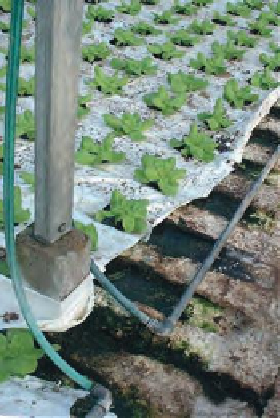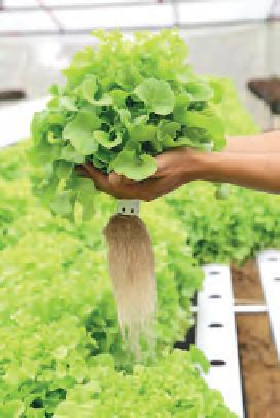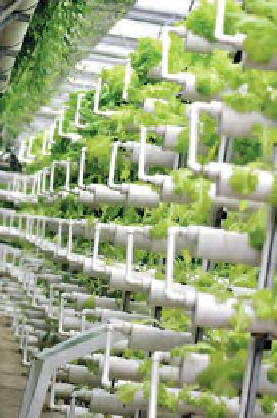Agriculture Reference
In-Depth Information
or on adjustable trays. There must be an even slope
with a minimum gradient of 1 in 100 with a flat bottom
usually lined with capillary matting to ensure a thin film
across the trough; areas of deeper liquid stagnate and
adversely affect root growth.
The nutrient solution can be prepared on site from
basic ingredients or proprietary mixes. It is essential
that allowance be made for the local water quality,
particularly with regard to the micronutrients such as
boron or zinc that can become concentrated to toxic
levels in the circulating solution. The nutrient level is
monitored with a conductivity meter (measuring salt
concentration levels) and by careful observation of the
plants. Monitoring pH and maintaining at the correct
level is also very important. Nutrient and pH control is
achieved using, as appropriate, a nutrient mix: nitric
acid or phosphoric acid to lower pH and, where water
supplies are too acid, potassium hydroxide to raise
pH. Great care and safety precautions are necessary
when handling the concentrated acids during
preparation.
The commercial NFT installations have automatic
control equipment in which conductivity and pH-
meters are linked to dosage pumps. The high- and
low-level points also trigger visual or audible alarms
in case of dosage pump failure. Dependence on the
equipment may necessitate the grower installing
fail-safe devices, a second lift pump and a standby
generator. A variation on this method is to grow
crops such as lettuce in gullies on suitably graded
greenhouse floors (Figure 15.4a) or vertically to
maximize floor area (Figure 15.4c). A characteristic of
plants grown in water culture is their lack of root hairs
(Figure 15.4b).
Aggregate culture
In aggregate culture, the nutrient solution is broken up
into water films by an essentially inert solid medium
such as coarse sand or gravel. More commonly today
are materials such as perlite, rockwool or expanded
clay aggregates (Figure 15.5). Rockwool, commonly
used as an insulation material, is derived from rock
which has been crushed, melted and spun into fibres.
This provides a lightweight, absorbent, inert and
sterile rooting medium usually supplied as polythene-
wrapped slabs and cubes. Similarly, perlite is derived
from rock which is crushed and the particles expanded
to 20 times their original size to produce white,
lightweight aggregate. These are porous with a rough
surface so perlite has good water-holding capacity.
Typical systems make use of rockwool as polythene-
wrapped slabs (Figure 15.6a), perlite in 'bolsters'
(Figure 15.6b) or aggregate clay granules in gullies.
These sit on a polythene-covered floor graded across
the row. Polyurethane sheets are often placed
underneath them to help create even slopes and
insulate them from the cooler soil below. The plants
are drip fed with a complete nutrient solution at
the top, with the surplus running out through slits
towards the bottom on the opposite side. Rockwool
slabs are a very successful way of growing and lend
themselves to a modular system. This method is
widely used for a range of commercial crops such
as tomatoes, cucumbers, peppers, melons, lettuce,
carnations, roses, orchids and strawberries in
protected culture.
When this method was first developed, the NFT
system was copied. However, the recirculation of
(a)
(b)
(c)
Figure 15.4
Hydroponic lettuce growing: (a) NFT in shallow troughs on the fl oor; (b) close-up of roots grown in
gullies fi lled with aggregate clay granules; (c) gullies arranged vertically to maximize cropping area





